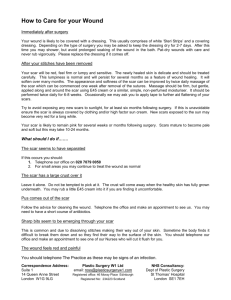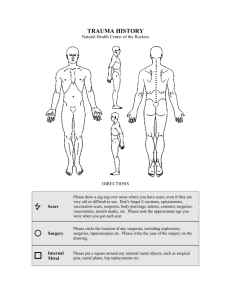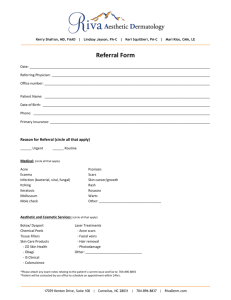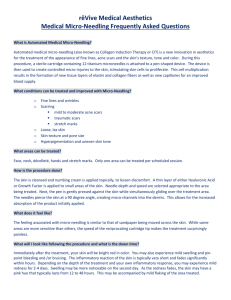Skin Scars
advertisement
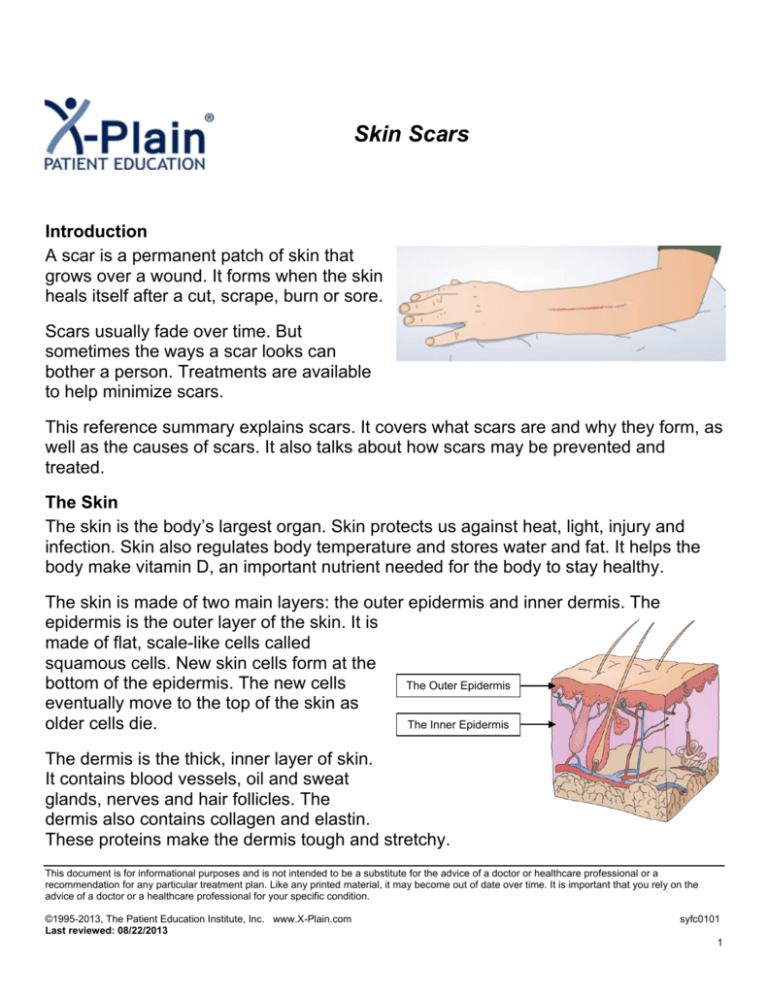
Skin Scars Introduction A scar is a permanent patch of skin that grows over a wound. It forms when the skin heals itself after a cut, scrape, burn or sore. Scars usually fade over time. But sometimes the ways a scar looks can bother a person. Treatments are available to help minimize scars. This reference summary explains scars. It covers what scars are and why they form, as well as the causes of scars. It also talks about how scars may be prevented and treated. The Skin The skin is the body’s largest organ. Skin protects us against heat, light, injury and infection. Skin also regulates body temperature and stores water and fat. It helps the body make vitamin D, an important nutrient needed for the body to stay healthy. The skin is made of two main layers: the outer epidermis and inner dermis. The epidermis is the outer layer of the skin. It is made of flat, scale-like cells called squamous cells. New skin cells form at the bottom of the epidermis. The new cells The Outer Epidermis eventually move to the top of the skin as The Inner Epidermis older cells die. The dermis is the thick, inner layer of skin. It contains blood vessels, oil and sweat glands, nerves and hair follicles. The dermis also contains collagen and elastin. These proteins make the dermis tough and stretchy. This document is for informational purposes and is not intended to be a substitute for the advice of a doctor or healthcare professional or a recommendation for any particular treatment plan. Like any printed material, it may become out of date over time. It is important that you rely on the advice of a doctor or a healthcare professional for your specific condition. ©1995-2013, The Patient Education Institute, Inc. www.X-Plain.com Last reviewed: 08/22/2013 syfc0101 1 Scars When skin or other tissues in the body are injured, the body starts to repair itself. Scars can form when the skin heals. If the dermis is damaged, the body makes more collagen. Collagen reconnects the tissue and heals the damage done to the skin. Once the skin is fully healed, the new tissue will look different from the skin around it. Most scars are thicker than the rest of the skin. Often they are also flat and pale. Scars may be pinker, redder or shinier than the rest of the skin. Sometimes scars may even be raised. This happens when the body makes more collagen than is needed to repair the damaged skin. Raised scars are more common in people who are young or have dark skin. Scars may also appear to be sunken or pitted. This can happen if the fat or muscle that supports the skin is lost. Acne and surgery may cause these types of scars. Stretch marks are another type of scar. These happen when the skin stretches quickly, such as during pregnancy. Stretch marks can also happen when the skin is trying to heal near a joint. How your scar looks depends on: • How big and deep the wound is. • How long the wound takes to heal. • Where the wound is located. • Your age. • Your inherited tendency to scar. Most scars fade over time. But they may not ever go away completely. Treatments are available if the scar’s appearance bothers you. Treatment Most of the time, scars do not require treatment. But treatments are available to minimize the appearance of scars. If the way a scar looks bothers you, you may want to seek treatment. This document is for informational purposes and is not intended to be a substitute for the advice of a doctor or healthcare professional or a recommendation for any particular treatment plan. Like any printed material, it may become out of date over time. It is important that you rely on the advice of a doctor or a healthcare professional for your specific condition. ©1995-2013, The Patient Education Institute, Inc. www.X-Plain.com Last reviewed: 08/22/2013 syfc0101 2 Treatment for scars can include: • Creams. • Injections. • Laser treatments. • Chemical peels. • Dermabrasion. • Surgery. Many creams are available that may help reduce the appearance of some scars. Examples are vitamin E creams and cocoa butter creams. These may or may not help minimize scars. Talk to your health care provider about which products may be effective for your scar. Different types of injections may also be used. Steroid injections can help flatten and soften the appearance of raised scars. These injections work by stopping the production of collagen. Filler injections can raise scars that are sunken or pitted. But filler injections are only temporary and may need to be done regularly. Laser treatments remove the upper layers of the skin using bursts of high-intensity light. Scar tissue can be removed without damaging surrounding skin. Newer lasers can work on the collagen in the dermis without removing the upper layers of skin. Chemical peels may be used to treat some types of scars, such as acne scars or scars that are deep. For this treatment, a chemical solution is applied to the skin. The solution will make the top layers of skin peel away. The skin that grows back after a chemical peel is smoother. Dermabrasion uses a rapidly rotating device to “sand” the outer layers of skin. The skin that grows back after dermabrasion is smoother. It can be used to improve the look of scars, such as those caused by acne, surgery, disease or injuries. Certain types of scars may be treated with surgery. Surgery cannot remove a scar, but it can make some scars less noticeable. Often surgery is not used for raised scars. These types of scars may get worse after this type of treatment. Dermabrasion This document is for informational purposes and is not intended to be a substitute for the advice of a doctor or healthcare professional or a recommendation for any particular treatment plan. Like any printed material, it may become out of date over time. It is important that you rely on the advice of a doctor or a healthcare professional for your specific condition. ©1995-2013, The Patient Education Institute, Inc. www.X-Plain.com Last reviewed: 08/22/2013 syfc0101 3 Preventing Scars The best way to prevent getting a scar is to protect your skin from wounds. Take safety precautions when you are playing sports or participating in other activities that can lead to skin cuts, scrapes, burns or sores. Even when being careful, it is still possible to injure the skin. Some scarring may be unavoidable. You can help prevent an unsightly scar by taking care of the wound properly. If you get injured, always clean out the wound right away. Run water over the wound and remove any foreign objects, such as pebbles or splinters. Then clean around the wound with soap and water. Keep the wound covered as it heals. This keeps germs, dirt and other irritants out. You can also use anti-bacterial ointment on a wound as it heals. This keeps bacteria from growing in the wound and keeps the wound moist. Letting the wound dry out can slow healing. Never pick at a wound or scab. Doing so tears the collagen that is forming to heal the skin. This may lead to a larger scar. It can also allow germs to get into the wound. Even if you take these steps and care for a wound properly, an unsightly scar can still form. Some people are more likely to form scars when their skin is injured. Some places on the body are more likely to scar than others. Even if a scar is likely to form, it is still important to care for the wound properly. This can prevent infection and help the wound heal faster. You should contact your health care provider after you get a wound if it is: • Bleeding heavily and will not stop. • Caused by a dirty or rusty object. • Deep or longer than ½ inch. • From an animal bite. • Located near the eye or on the face. This document is for informational purposes and is not intended to be a substitute for the advice of a doctor or healthcare professional or a recommendation for any particular treatment plan. Like any printed material, it may become out of date over time. It is important that you rely on the advice of a doctor or a healthcare professional for your specific condition. ©1995-2013, The Patient Education Institute, Inc. www.X-Plain.com Last reviewed: 08/22/2013 syfc0101 4 Always watch for signs of infection if you have an open wound. These include: • Body aches. • Fever or chills. • Increased warmth or tenderness around the wound. • Pus coming from the wound. • Redness or swelling around the wound site. • Swollen lymph nodes. Contact your health care provider if you have the symptoms of an infection. Getting medical treatment in a timely manner can also prevent or reduce scarring. Summary A scar is a permanent patch of skin that grows over a wound. It forms when the skin heals itself after a cut, scrape, burn or sore. Collagen reconnects damaged tissue and heals the skin. Most scars are thicker than the rest of the skin. Often they are also flat and pale. Scars may be pinker, redder or shinier than the rest of the skin. They may also be raised, sunken or pitted. Scars usually fade over time. But sometimes the way a scar looks can bother a person. Treatments are available to help minimize scars. Treatment can include: • Creams. • Injections. • Laser treatments. • Chemical peels. • Dermabrasion. • Surgery. The best way to prevent getting an unsightly scar is to protect your skin from wounds. But even when being careful, it is still possible to injure the skin. You can help prevent an unsightly scar by taking care of the wound properly. But not all unsightly scars can be prevented. This document is for informational purposes and is not intended to be a substitute for the advice of a doctor or healthcare professional or a recommendation for any particular treatment plan. Like any printed material, it may become out of date over time. It is important that you rely on the advice of a doctor or a healthcare professional for your specific condition. ©1995-2013, The Patient Education Institute, Inc. www.X-Plain.com Last reviewed: 08/22/2013 syfc0101 5

